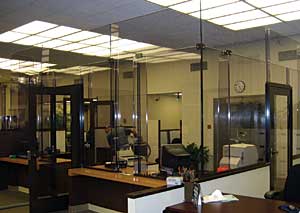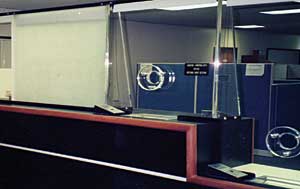Designing Bullet Resistant Protection Panel Systems: Capture More than the Imagination
Establishing a Bullet Resistant Standard
There are a number of agencies that test and certify materials to be bullet resisting. The most common are: HPW (H.P. White), NIJ (U.S. Department of Justice), British Standards Institute, European Standard, ASTM (American Society for Testing and Materials). There are many more national and international independent laboratories that test materials to the manufacturers specification. Some agencies are more qualified however to provide testing in the area of body protection; bulletproof vests, and armored vehicles, than ballistic panel systems for buildings.
 |
| Bank of West Baldwin Park. Vertical Offset Design with Jump Shield Photo credit: Bullet Guard |
The testing agency that is most commonly specified in the building industry and used by manufacturers is Underwriters Laboratories (UL). The UL bullet resisting section is referred to as Standard 752. Manufacturers refer to the test for in the common abbreviation UL-752. This Standard is accepted in the United States as the industry guide because its tests are consistent and performed independently without prejudice.
|
|||||||||||||||||||||||||||||||||||||||||||||
Adherence to this standard insures that all the materials being tested or certified will correctly meet the various Levels of Protection as determined by the anticipated threat. Most importantly, because UL has its own standards and requires follow-up testing, the manufacturers cannot control the test or change the product after UL certification has been received. This standard of care when specifying UL rated materials can reduce owner's liability, and provide some assurance to the end user against product failure in the event of an attack or disaster. This standard is also critical to developing quality assurances by individual manufacturers.
UL-752 covers materials, devices, and fixtures used to form bullet-resisting barriers, protecting against robbery or holdup or terrorist acts among other disasters. Under UL-752 the term "bullet-resisting" signifies "that protection is provided against complete penetration, passage of fragments of projectiles, or spalling (fragmentation) of the protective material to the degree that injury would be caused to a person standing directly behind the bullet resistant barrier."
Underwriters' testing is done to precise laboratory conditions for extreme cold, extreme heat and room temperature, at precise distances from the weapon, and exact ammunition requirements. This criteria directly impacts the architect's specifications for use of materials.
 |
| Voice Ports, circular design Photo credit: Bullet Guard |
Experience has shown, the security industry as a whole, may not agree with the format of these tests but the industry has accepted this consistent method to provide assurance of standards. UL does not recognize standards based upon tests performed at uncontrolled locations such as shooting ranges or in open field tests, which allow for too many variables. The added risk of providing inconsistencies in data feedback serves to prove these test unvaluable or even harmful to the materials purchaser.









